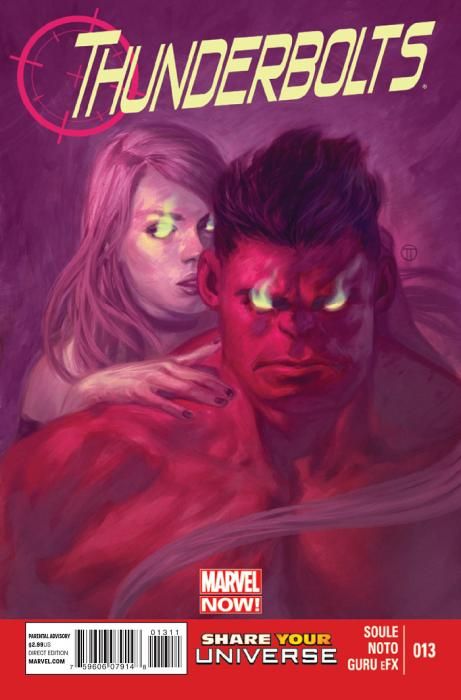"Thunderbolts" #13 by Charles Soule and Phil Noto is a powerful character study of Mercy, the most recent, most mysterious and possibly the most powerful addition to Red Hulk's strike team.
For readers unfamiliar with Mercy from her previous appearances in "The Incredible Hulk," "Thunderbolts" #13 assumes no previous knowledge. Mercy is the focus of the story, but she is more object than subject. Instead, Venom and Red Hulk, the lesser "monsters," are stand-ins for the reader. Venom was underused in Daniel Way's opening storylines for "Thunderbolts," and it's gratifying that Soule picks Venom off the bench specifically for his personality and his past.
Venom confronts Mercy, already disturbed and tense, and on third page of "Thunderbolts" #13, Soule throws in sudden and alarming twist that throws Venom even further off-balance. Her morality is both unusual and simplistic, with a binary classification of all humanity into those who have need of her "mercy" and those who do not. Mercy's belief that she is a Good Samaritan is convenient, since it benefits from death. Thus, she is doubly attached to her self-appointed mission to fulfill her twin drives of power and service.
Soule's speech patterns for Mercy -- detached, pragmatic, and almost mechanical -- reinforce the power of this scene, as do Noto's character design and facial expressions. Noto focuses heavily on Flash Thompson's face as he tries to question Mercy, emphasizing Venom's humanity over his more threatening-looking alien symbiote.
Noto also dresses Mercy in a simple costume, like a cross between the garb of a goddess and a nun. While Flash Thompson's face runs through a gamut of emotions, primarily fear, Mercy's face is steady in its calm repose. She reacts to nothing with much feeling, except for when she thinks of one moment in which Venom "needed" her "mercy," and that moment is far in the past. The subtle horror of her logic is already there in how Noto depicts the inner-focused expression of her young face and in her unbending body language. Her peaceful face and immovable logic only magnify the horror of her power allied to her purpose.
One of the best lines in "Thunderbolts" #13 is Red Hulk's recounting to Venom, "[she] let them believe they were in the presence of real divinity, although honestly, who's to say that they weren't?" Nevertheless, despite his awe of her powers, he struggles to explain to Mercy that her mission and methods are not merciful, but opportunistic. Their physical combat over three pages adds some visual spark, but Soule's words are the heart of the story. Red Hulk differs from Mercy in his understanding of free will and intervention and in his beliefs in complexity and limitations of grief and despair, revealing that despite his unorthodox methods, he has a sympathetic and intelligent moral code.
"Thunderbolts" #13 is a subtler, stronger character study than Soule's Punisher story of the previous issue, making better use of his strengths in characterization, psychological tension and thematic depth. "Thunderbolts" will be an exciting title to follow if Soule continues on these lines as he develops his vision of a team of complex monsters with conflicting codes of ethics.

